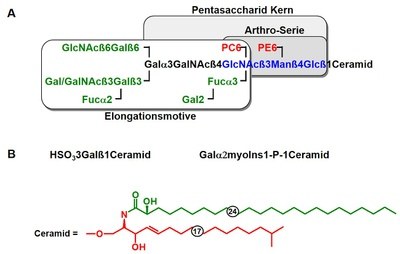AG Lochnit - Glycosphingolipids of nematods
For the characterization and structural analysis of the glycosphingolipids from nematodes we developed a separation protocol and chemical methods for the preliminary determination of the amphoteric glycosphingolipids [1], using A. suum as model organism. The separation revealed the presence of neutral, amphoteric and acidic glycosphingolipids. Since we expected that the amphoteric glycosphingolipids corresponded, with respect to their carbohydrate backbone, to the neutral structures, we structurally elucidated these glycolipids first.
After separation of the acidic glycosphingolipids from the neutral fraction by anion-exchange chromatography, we could subdivide the neutral fraction into a neutral and neutral-zwitterionic fraction by silica-gel chromatography [2,3]. High performance liquid chromatography (HPLC) separation of the neutral fraction revealed the presence of ceramide mono-, di, tri- and pentahexosides. The carbohydrate structures were elucidated by matrix-assisted laser desorption-ionization time-of-flight mass spectrometry (MALDI-TOF-MS), carbohydrate composition analysis, liquid secondary-ion mass spectrometry (LSIMS), nuclear magnetic resonance spectroscopy (NMR), gas-liquid chromatography-mass spectrometry (GLC/MS), methylation analysis and sequential exoglycosidase treatments. The results revealed that the carbohydrate structures were based on the so-called arthro-series, which had been previously described for the insects C. vicina and Lucilia caesar [4-6]. The four glycosphingolipids elucidated reflected a biosynthetic pathway with the pentasaccharide Gala1-3GalNAcß1-4GlcNAcß1-3Manß1-4Glc as the most complex structure (see Fig. 7). Not only the carbohydrate backbone, but also the ceramide moiety of the neutral glycosphingolipids from A. suum showed remarkable peculiarities. Cerebronic acid (C24h:0) was found to be the dominating fatty acid, whilst the sphingoid bases comprized iso-branched C17 sphingosine, sphinganine and phytosphingosine.

copyright: private
During our initial characterization of the amphoteric glycosphingolipids, we could already show that this fraction consisted of two major compounds (components A and C) and several minor components [1]. Both major compounds contained for phosphate and choline, the latter also a free amino group. By silica-gel column chromatography, we could isolate components A and C and two fractions, B1 and B2, comprizing mixtures of minor compounds [7]. HPTLC immunostaining with a phosphorylcholine-specific antibody showed a positive reaction with all fractions, whereas HF treatment abolished the immunoreactivity. Also, HF-treatment of components A and C resulted in a single glycosphingolipid with migration properties similar to the ceramide pentahexoside from the neutral fraction. Since staining for amino groups was also negative after HF treatment, we concluded that component C contained a further phosphate-linked substituent, most probably ethanolamine. This could be confirmed by its identification as the 9-fluorenyl-methoxycarbonyl derivative. Choline was further identified after derivatization with pentafluoropropionic acid anhydride and LSIMS analysis. Consistent with these data, carbohydrate composition analysis revealed the presence of Glc, Gal and GalNAc for both components and, in addition, Man for component A. Following HF treatment, GlcNAc was found as an additional monosaccharide residue in both compounds. Due to its lability under strong alkaline conditions, the phosphorylethanolamine (PE) substituent was found to be eliminated during permethylation, thus resulting in similar methylation analysis data for both components. This confirmed the arthro-series pentasaccharide core structure of the neutral fraction for both components A and C. Nevertheless, the GlcNAc residue was only detected after HF treatment, to allow the localization of the PC-substituent to this monosaccharide residue. A methylation step converting PE to PC, and subsequent methylation analysis, allowed the assignment of the PE-substituent to the Man residue. For the exact localization of the substitution positions, HF treatments were performed either before or after the permethylation step and indicated that the amphoteric substituents PC and PE were bound at C6 of GlcNAc and C6 of Man, respectively. These structural data could be further confirmed by NMR. Component C represented the first glycosphingolipid carrying two zwitterionic substituents. Mass spectrometric analyses showed characteristic fragmentation behavior of these glycosphingolipids in MALDI-TOF-MS due to the loss of the trimethylamine group of choline and formation of a cyclic phosphotriester in the case of component A and loss of ethanolamine in the case of component C. This fragmentation pattern can, therefore, be regarded as a fingerprint to identify molecules substituted with these zwitterionic substituents.
Literature:
[1] Dennis RD, Lochnit G, Geyer R. Strategies for preliminary characterization of novel amphoteric glycosphingolipids. Methods Mol Biol 1998;76:197-212.
[2] Lochnit G, Dennis RD, Zähringer U, Geyer R. Structural analysis of neutral glycosphingolipids from Ascaris suum adults (Nematoda: Ascaridida). Glycoconj J 1997;14:389-99.
[3] Sugita M, Mizunoma T, Hayata C, Hori T, Nakatani F, Aoki K. Classification into arthro-series of neutral glycosphingolipids from porcine roundworm, Ascaris suum, (Aschelminthes, Nematoda) [in Japanese]. J. Jpn. Oil Chem. Soc. 1994;43:495-501.
[4] Dennis RD, Geyer R, Egge H, Menges H, Stirm S, Weigandt H. Glycosphingolipids in insects. Chemical structures of ceramide monosaccharide, disaccharide and trisaccharide from pupae of Calliphora vicina (Insecta: Diptera). Eur J Biochem 1985;146:51-8.
[5] Dennis RD, Geyer R, Egge H, Peter-Katalinic J, Li SC, Stirm S, Wiegandt H. Glycosphingolipids in insects. Chemical structures of ceramide tetra-, penta-, hexa- and heptasaccharides from Calliphora vicina pupae. (Insecta: Diptera). J Biol Chem 1985;260:5370-5.
[6] Hori T, Sugita M. Sphingolipids in lower animals. Prog Lipid Res 1993;32:25-45.
[7] Lochnit G, Dennis RD, Ulmer AJ, Geyer R. Structural elucidation and monokine-inducing activity of two biologically active zwitterionic glycosphingolipids derived from the porcine parasitic nematode Ascaris suum. J Biol Chem 1998;278:466-74.
